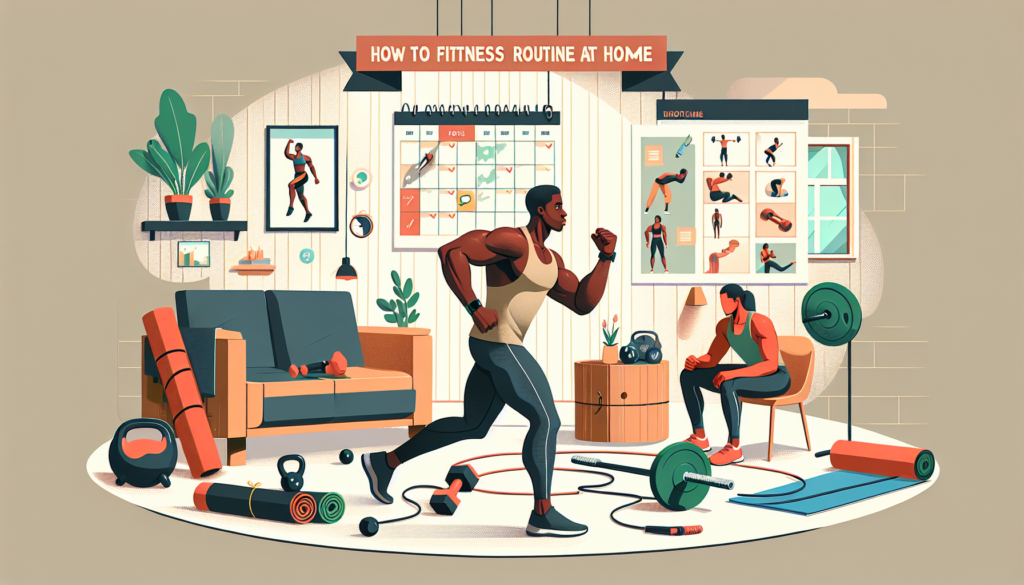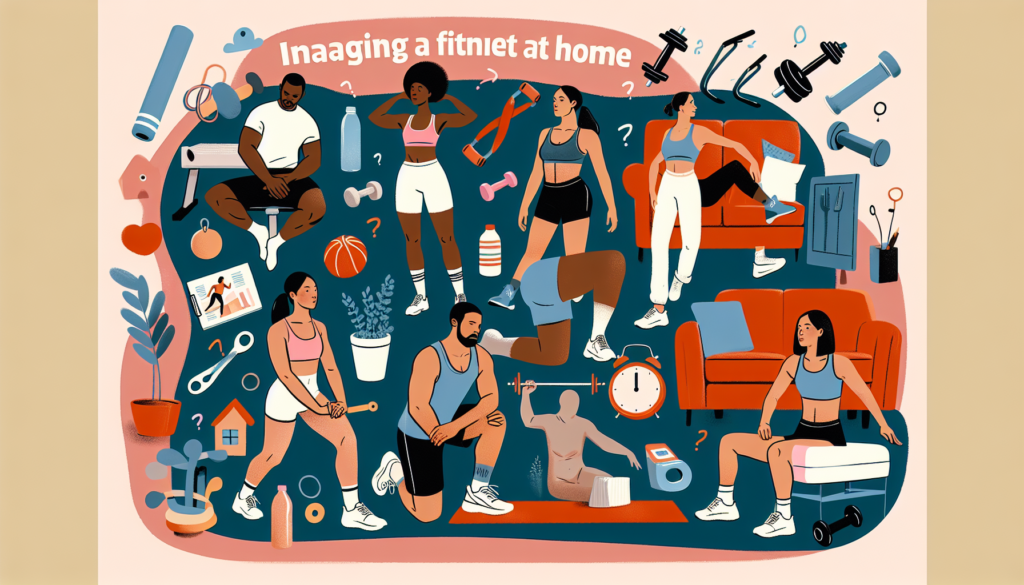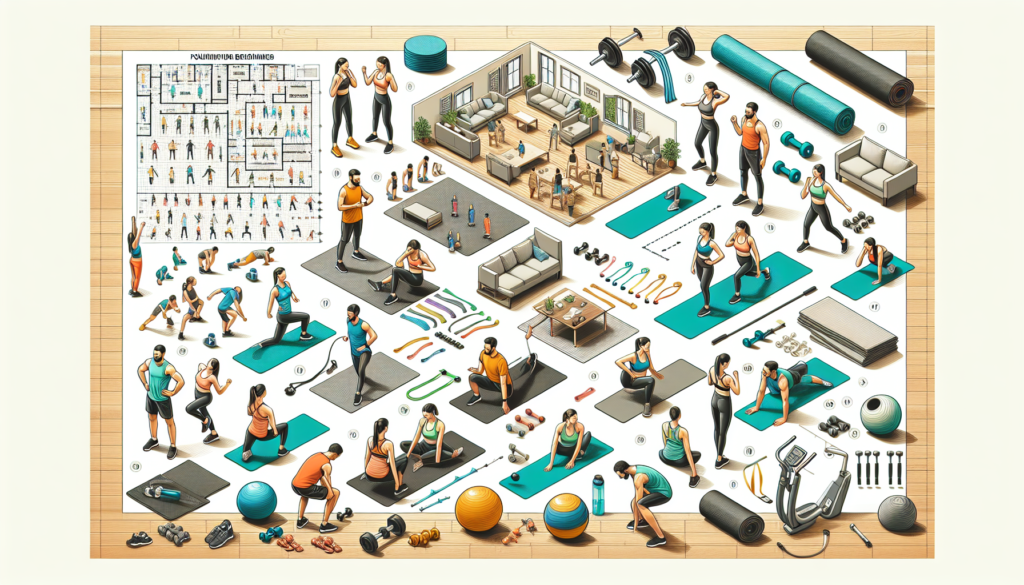So you’ve decided to kickstart a fitness routine right at the comfort of your own home, but you have no idea where to begin? Don’t worry, we’ve got you covered. In this article, we’ll provide you with a simple guide on how to start a fitness routine at home, no pricey gym memberships or fancy equipment required. Whether you’re a beginner or someone who wants to shake up their regular exercise routine, these tips and tricks will help you get started and stay motivated along the way. Get ready to break a sweat and achieve your fitness goals while staying right where you are.
Setting fitness goals
When starting a fitness routine at home, it’s essential to first identify your fitness goals. What do you want to achieve? Do you want to lose weight, build muscle, or improve your overall fitness level? Once you have a clear understanding of your goals, you can then make them specific and achievable. For example, instead of saying “I want to lose weight,” you could say “I want to lose 10 pounds in the next three months.” By setting specific and achievable goals, you can stay motivated and track your progress more effectively. Additionally, it’s important to set a timeline for your goals. This will help you stay on track and give you a sense of direction in your fitness journey.
Creating a workout space
To create an effective workout space at home, it’s important to designate a dedicated area specifically for exercise. This could be a spare room, a corner in your living room, or even your backyard. The key is to choose a space where you can focus and have enough room to move freely. Once you have chosen the area, clear out any clutter and create a comfortable environment. Consider adding some inspiring elements like motivational quotes or posters to keep you motivated. Additionally, gather essential equipment such as dumbbells, resistance bands, a yoga mat, and any other equipment you may need for your chosen workout routine.

Choosing the right workout program
Selecting the right workout program is crucial to ensure you stay motivated and enjoy the exercises you are doing. Consider your fitness level and preferences when choosing a program. Are you a beginner or at an intermediate level? This will help you determine the intensity and complexity of the program you should start with. Furthermore, explore various types of workouts such as cardio, strength training, and flexibility exercises. This will help you find a routine that suits your interests and helps you achieve your goals. It is also advisable to consult with a fitness professional who can guide you in choosing the right program based on your specific needs and limitations.
Designing your workout schedule
Creating a workout schedule is vital to establish a routine and ensure consistency in your fitness journey. Decide on the frequency of your workouts based on your availability and fitness goals. Aim for at least three to five workouts per week to see noticeable results. Allocate specific time slots for exercising that fit into your daily schedule. Whether it’s early in the morning, during your lunch break, or in the evening, choose a time that works best for you and commit to it. Additionally, don’t forget to include rest days in your schedule. Rest and recovery are just as important as exercise, as they allow your body to repair and recharge for optimal performance.

Warm-up and cool-down routines
Before jumping into your workout, it’s crucial to understand the importance of warm-up exercises. A warm-up prepares your body for the upcoming physical activity by increasing blood flow to your muscles and loosening your joints. Incorporate dynamic stretching techniques, such as arm circles, leg swings, and trunk rotations, to improve mobility and flexibility. These exercises not only prevent injuries but also enhance your performance during the workout. After completing your workout, don’t forget to include cool-down exercises. Cooling down helps your body gradually return to its resting state, reduces muscle soreness, and promotes flexibility. Stretching your major muscle groups and performing gentle cardio exercises, like walking or light jogging, are effective ways to cool down.
Cardiovascular exercises
Cardiovascular exercises are excellent for improving your heart health, burning calories, and increasing overall fitness. When choosing cardio activities, opt for those you enjoy to stay motivated and engaged. Whether it’s running, cycling, dancing, or swimming, find something that brings you joy and gets your heart pumping. If you’re just starting, begin with low-impact workouts like brisk walking or using a stationary bike. As you progress, gradually increase the duration and intensity of your workouts to challenge yourself and improve your cardiovascular endurance. Remember to listen to your body, take breaks when needed, and stay hydrated throughout your cardio sessions.

Strength training exercises
Strength training exercises are essential for building muscle, improving bone density, and increasing overall strength. Start by learning basic strength exercises that target major muscle groups, such as squats, lunges, push-ups, and planks. You can perform these exercises using your body weight or incorporate resistance bands for added intensity. As you gradually build strength and confidence, progress to using weights, such as dumbbells or barbells, to further challenge your muscles. It’s important to maintain proper form and technique during strength training to prevent injuries and maximize results. Additionally, give your muscles time to recover between sessions, as this is when they grow and become stronger.
Flexibility and mobility exercises
Flexibility and mobility exercises are often overlooked but are crucial for maintaining joint health and preventing injuries. Incorporate stretching into your workout routine to increase your range of motion and improve flexibility. Static stretches, where you hold a stretch for a prolonged period, can be done at the end of your workout or during rest days. You can also try yoga or Pilates, as these disciplines focus on both strength and flexibility. They provide an opportunity to challenge your body in a different way while enhancing your overall mobility. Additionally, include exercises that specifically target mobility, such as hip circles or shoulder rolls, to improve joint function and reduce the risk of injuries.

Tracking your progress
To stay motivated and see how far you’ve come, it’s essential to track your progress. Keeping a fitness journal or using a fitness app can help you stay organized and record your workouts, including the exercises performed, duration, and intensity. It can also be helpful to take regular measurements, such as weight, body measurements, or body fat percentage, to track changes in your body composition. Additionally, monitor improvements in strength and endurance by recording the number of repetitions or the amount of weight lifted during strength training exercises. Celebrate your achievements along the way and use them as a source of motivation to keep pushing yourself.
Seeking professional guidance
If you feel overwhelmed or unsure about starting a fitness routine at home, consider seeking professional guidance. Hiring a personal trainer can provide tailored workouts, guidance on proper form, and accountability. They can customize a program based on your goals, fitness level, and any limitations or injuries you may have. Additionally, consulting with a nutritionist can provide valuable guidance on the right diet and nutrition for your fitness goals. They can help you create a meal plan that supports your workouts and ensures you’re fueling your body properly. Lastly, take advantage of online fitness programs and resources, many of which offer comprehensive workout routines and nutritional guidance that can be done from the comfort of your home. These resources often provide videos, tutorials, and support that can help you stay motivated and on track.
